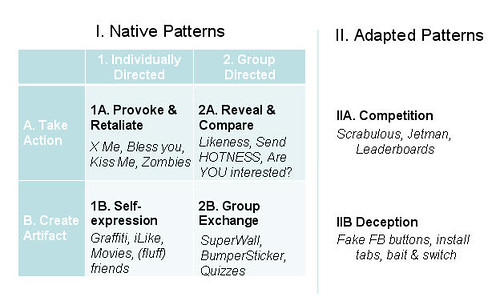
I found this slideshare show by Michael Weiksner, BJ Fogg, and Xing Kin Lui from a class at Stanford called “Creating Engaging Applications on Facebook.” They are taking a multi-disciplinary look at applications, including a focus onpersuasion technology. The visual shows the results of a pattern analysis of the 100 most popular Facebook applications (video of lecture here). What’s noted: “Adapted patterns are also cross-cutting techniques for increasing engagement and revenue.”
This analysis caught my eye because helped crystalize some thinking about Facebook causes based on an experiment I did as part my fundraising for the Sharing Foundation’s America’s Giving Challenge (please consider donating $10). According to this analysis, Causes probably falls in the Adapted Patterns/Competition.
My colleague, Priscilla Brisbane from Australia (who is conducting her own online fundraising experiment) wrote a post about Levels of Engagement.

In my levels of engagement chart, a simple action involves befriending (e.g. MySpace), subscribing, forwarding and/or learning. An easy action involves blogging, signing petitions, protesting and/or wearing a badge/shirt/wristband. A specific action involves donating, volunteering, finding events to attend, downloading and using online materials offline and/or creating and uploading video/images. Once you become an active member, you are doing offline actions more than online actions.
How does this play out in Facebook causes – particularly if you are starting as an individual or extra organizational activist. You are invitation your friends …but cause invitation (at least in the America’s Giving Challenge) comes with a request for a specific action – donate! So, maybe that’s why the low percentage of donors to joiners – even with an incentive of raising more money for the cause. In addition, the interface or interaction design doesn’t make it easy to get people who’ve joined personally involved. It makes hard to implement what Priscilla suggests below and what I feel works for increased engagement.
Now there’s one slight problem for us online campaigners in all of this, and that’s how do we move supporters and activists from one point on the chart to the next? Particularly up the “sympathisers” end, it can be very difficult to move people along to the next level of engagement. I believe such committment needs to come from each individual, after all we’re not like priests “converting” people, all we can do is provide people with information and tools because people will be more committed once they can relate to a cause through personal experience rather than be guilt-tripped into participation 🙂 Feel welcome to debate this with me, though.
Anyway, I think that the best way to encourage supporters to become activists is simply to ask them how they want to be more involved. Sometimes when I do this, they are honoured that I’ve asked. Other times, they apologise that they can’t help right now because of personal circumstances. Nobody has abused me yet, so I’ll remain with this strategy for now and will let you know in time how I get on!

Priscilla also introduced me Nicholas Street’s work as well as Participate Online – User Motivation in Mass Participation (PDF) – the research seems to have been commissioned by the BBC and carried out by Sparkler in the UK. Need to go digest.
So, how does the “competition” pattern for Facebook Design (for Causes) relate to a pattern that many activists use — the ladder of engagement? Does the ladder of engagement apply to everyone or is it different based on your age/generation and/or comfort in using online tools? Does competition really help engage people in a cause? Has anyone done any research on this topic? What am I not seeing?
